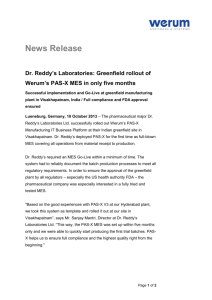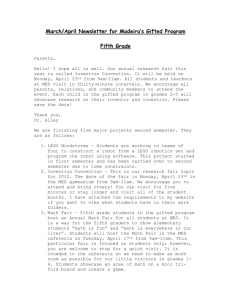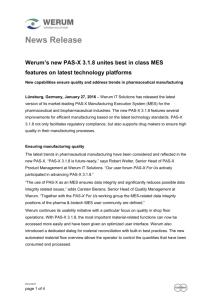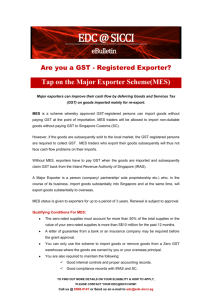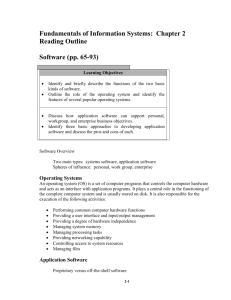SHOP FLOOR INFORMATION SYSTEMS EMERGING AS
advertisement
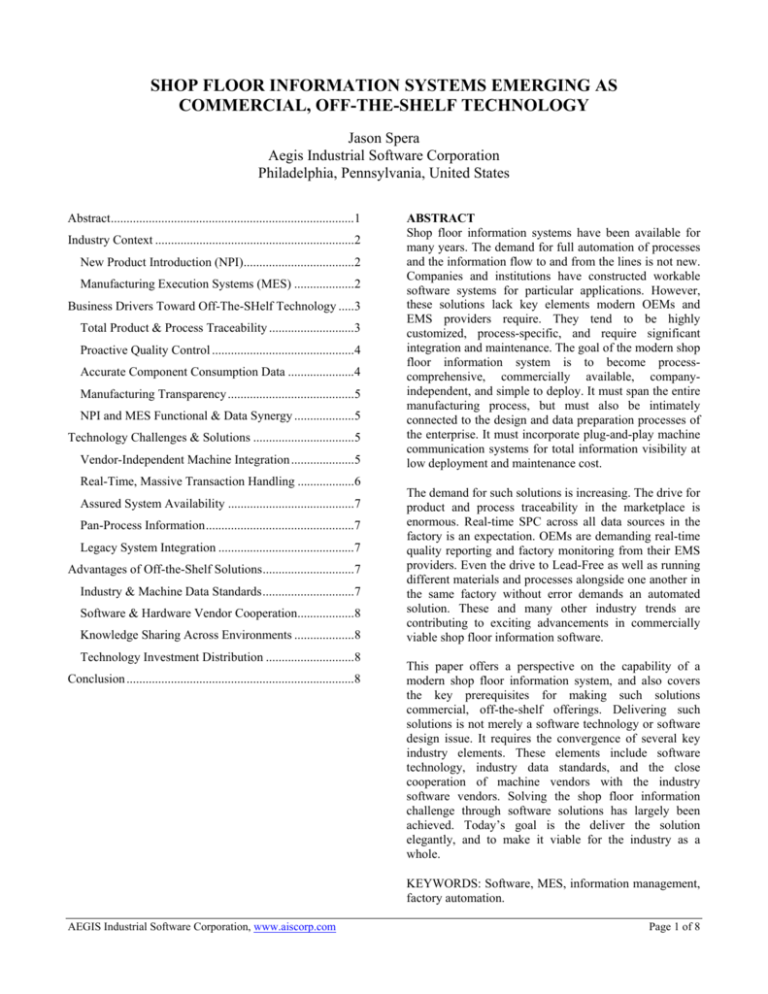
SHOP FLOOR INFORMATION SYSTEMS EMERGING AS COMMERCIAL, OFF-THE-SHELF TECHNOLOGY Jason Spera Aegis Industrial Software Corporation Philadelphia, Pennsylvania, United States Abstract.............................................................................1 Industry Context ...............................................................2 New Product Introduction (NPI)...................................2 Manufacturing Execution Systems (MES) ...................2 Business Drivers Toward Off-The-SHelf Technology .....3 Total Product & Process Traceability ...........................3 Proactive Quality Control .............................................4 Accurate Component Consumption Data .....................4 Manufacturing Transparency ........................................5 NPI and MES Functional & Data Synergy ...................5 Technology Challenges & Solutions ................................5 Vendor-Independent Machine Integration ....................5 Real-Time, Massive Transaction Handling ..................6 Assured System Availability ........................................7 Pan-Process Information...............................................7 Legacy System Integration ...........................................7 Advantages of Off-the-Shelf Solutions.............................7 Industry & Machine Data Standards.............................7 Software & Hardware Vendor Cooperation..................8 Knowledge Sharing Across Environments ...................8 Technology Investment Distribution ............................8 Conclusion ........................................................................8 ABSTRACT Shop floor information systems have been available for many years. The demand for full automation of processes and the information flow to and from the lines is not new. Companies and institutions have constructed workable software systems for particular applications. However, these solutions lack key elements modern OEMs and EMS providers require. They tend to be highly customized, process-specific, and require significant integration and maintenance. The goal of the modern shop floor information system is to become processcomprehensive, commercially available, companyindependent, and simple to deploy. It must span the entire manufacturing process, but must also be intimately connected to the design and data preparation processes of the enterprise. It must incorporate plug-and-play machine communication systems for total information visibility at low deployment and maintenance cost. The demand for such solutions is increasing. The drive for product and process traceability in the marketplace is enormous. Real-time SPC across all data sources in the factory is an expectation. OEMs are demanding real-time quality reporting and factory monitoring from their EMS providers. Even the drive to Lead-Free as well as running different materials and processes alongside one another in the same factory without error demands an automated solution. These and many other industry trends are contributing to exciting advancements in commercially viable shop floor information software. This paper offers a perspective on the capability of a modern shop floor information system, and also covers the key prerequisites for making such solutions commercial, off-the-shelf offerings. Delivering such solutions is not merely a software technology or software design issue. It requires the convergence of several key industry elements. These elements include software technology, industry data standards, and the close cooperation of machine vendors with the industry software vendors. Solving the shop floor information challenge through software solutions has largely been achieved. Today’s goal is the deliver the solution elegantly, and to make it viable for the industry as a whole. KEYWORDS: Software, MES, information management, factory automation. AEGIS Industrial Software Corporation, www.aiscorp.com Page 1 of 8 Shop Floor Information Systems Emerging as Commercial, Off-the-Shelf Technology INDUSTRY CONTEXT Manufacturing software, particularly the aspects related to shop-floor information management, are critical in the electronics manufacturing factory. Once considered essential only in large-company environments for unitlevel product tracking and materials management, and perhaps for use by the financial functions of the ERP system, they are quickly becoming important to a broad range of manufacturers. As with all technology, the early adopters tolerate high cost, complexity and customization. The early adopters of shop-floor information systems in electronics manufacturing tolerated these issues as well. They dealt with the issue typically by engineering their own solutions, or by selecting a software system in addition to system integration services. However, as the need for the technology broadened across most of the industry, there was a significant drive toward commercial, off-the-shelf technology able to deploy quickly and deliver the desired capability with very little customization. Electronics assembly introduces unique barriers to the emergence of viable off-the-shelf software solutions. Issues such as the existence of component reference designators. The depth of this data is well in excess of that required in typical discrete manufacturing. The complexity of the design information and the data emerging from test is also unique. The impending transition to lead free chemistries and the tracking of such information presents entire new information and shop floor management challenges. Overall, electronics assembly presents significant barriers to the creation of an ‘off-the-shelf’ solution that offers minimized customization as well as comprehensive manufacturing information management. For the purpose of discussion in this paper, certain software categories have been utilized. The term ‘manufacturing software’ spans many subsets of software solutions designed to fulfill different needs in a manufacturing enterprise. In addition, there exist no globally recognized segmentations of these systems. To facilitate explanation and discussion, a commonly accepted grouping of solutions into New Product Introduction Software (NPI) and Manufacturing Execution Systems (MES) is utilized throughout. The acronym (MES) is generally used interchangeably with shop floor information system. New Product Introduction (NPI) NPI software is the first phase of data processing as the bill of materials and electronic CAD design data for the electronics product enters the factory for preparation on its way to production. NPI systems are typically used by manufacturing engineering and component engineering personnel. While various vendor offerings differ, they tend to have common functions. For example, most convert the wide range of CAD formats into a normalized AEGIS Industrial Software Corporation, www.aiscorp.com graphical and intelligent rendering of the electronics product complete with discrete components. They have some means of importing and cleaning errors from the bill of materials (BOM), and joining this data into the design data to form a complete product definition. The BOM functions of these tools have evolved in recent years to include comprehensive component engineering and the management of approved vendor numbers and manufacturer numbers. These are commonly considered the preparation phases. The output phases involve the development of a process routing suitable for the product, automatic generation of visual aids for line operators and inspectors, and the optimization and program generation for the production machinery. In summary, the NPI tools prepare the entire process and product data set required to properly manufacture the product when it enters production. Traditionally, including NPI systems in a discussion of shop floor information management solutions would appear incongruous. This common perception drove most manufacturers to consider and select their NPI software independently of their MES software selections. Unfortunately, the data and functional synergy of the two systems is critical to the overall solution, and considering them separately increases the customization efforts required to implement a total solution. A key element of the move toward commercial, off-the-shelf shop-floor information systems relies upon achieving seamless functional and data interaction among the NPI and MES solutions of the factory, an interaction to be further discussed later in this paper. When both are considered in concert, the resultant system solution is less expensive and delivers superior functionality. Manufacturing Execution Systems (MES) MES spans many functional areas, but is limited to software functions utilized on the factory floor itself. The author has found that when asked, virtually every industry professional will define MES differently. Their definition will often be of a single element of an overall MES solution rather than the whole. Commonly, it will be considered tracking of unit-level product movement through the routing, or perhaps quality data collection and reporting. Others define machine control or monitoring tools as an MES solution. These narrow definitions are likely due to the fact that until recently, these functions were all that were required of an MES solution. Today, these capabilities are actually only a fraction of the overall functionality most assemblers demand of a total MES solution. Similar to the danger posed by separating NPI from MES, the consideration of MES solutions in a narrow functional scope leads to minimized capabilities, followed by customization requirements in the near future to meet expanding needs Page 2 of 8 Shop Floor Information Systems Emerging as Commercial, Off-the-Shelf Technology Figure 1: Software Elements of the Factory Total MES spans a few distinct areas of functionality, with many individual capabilities within each. These areas include: 1) Delivery of prepared data to the factory floor such as visual and textual operator instructions. 2) Line, materials, and process setup validation to electronically ensure proper configuration of the process. 3) Execution of the product flow and route validation 4) Data acquisition from the machines, operators, and test 5) Repair automation and data tracking, 6) Analysis of the incoming data from all prior steps using methods such as SPC 7) Reaction to this analysis and executing automatic control and alarming, and 8) Reporting and near real-time visibility to all of the data resulting from the prior steps throughout the enterprise, and/or making this information available to other business systems. Of course, not all of these functions are required by every enterprise. This functional scope is required when the maximum depth of process analysis and traceability is demanded either by the manufacturer themselves, their customers, or government regulation of some kind. To achieve the full scope outlined, manufacturers have turned to a variety of means. In-house custom-developed solutions could sometimes approach this capability. In other cases, the manufacturer would select multiple solutions with advantages in each area, and then seek integration services to deliver the interoperability they required. These methods and others like them often failed to deliver the total functionality desired by the organization. In almost all cases, the resultant solution was costly, both initially and on a recurring basis, and lacked the architectural elegance required to evolve smoothly into the future. BUSINESS DRIVERS TOWARD OFF-THE-SHELF TECHNOLOGY As mentioned, MES solutions are not new, and there are many vendors offering various forms of systems. However, in actuality these vendors offer a combination of software product and services to deliver a full solution. AEGIS Industrial Software Corporation, www.aiscorp.com Traditional MES software solutions are actually a combination of a software product in the form of an engineering toolkit and a contract of services to customize it to a particular business environment. In essence, there is little difference between a manufacturer choosing to develop their own MES solution and purchasing traditional MES software. The distinction exists at two levels; in the location of the customization services, either in-house personnel or contracted to the external vendor, and in the fact that the vendor is beginning with the base toolkit, whereas the in-house team begins from the ground-up. In either case, the system will not be useful until significant integration, engineering, and customization is conducted. This model was workable when the business requirements for the system were limited in scope, such as product tracking and quality collection. Even line control and validation could be handled in this manner. However, business requirements for more sophisticated functionality are bearing on manufacturers now, and are exceeding the ability of generic MES systems customized to a particular environment such as electronics manufacturing. The following sections discuss key business drivers challenging electronics manufacturers regarding their shop floor information management and why traditional customized systems are having difficulty meeting the challenges. Total Product & Process Traceability The depth and scope of ‘traceability’ has expanded significantly in recent years. Military, aerospace, and medical OEM’s have long had contractual obligations to maintain records of the components populated to their assemblies. These requirements are often passed down to contractors. Manufacturers were often meeting these requirements with either manual systems or through point solutions appended to individual production machines or systems. This was adequate until recently when the requirements extended beyond population data only. The requirements have increased in data depth such as with population data down to a reference designator and lot level. They have also increased in scope to include process data from printers, ovens, dispensers, and virtually every machine and operator station along the routing. Traceability now includes a broad variety of process parameters the product encountered during its production as well as the lot numbers of the components installed upon it. Chemicals and materials used in the process must also be traced back to the product. This has become particularly important with the advent of lead-free. This constraint introduces a new range of technical requirements to validate both that the proper chemical was setup for the process, and then to trace which chemical was actually used on the product. Page 3 of 8 Shop Floor Information Systems Emerging as Commercial, Off-the-Shelf Technology Quality and test data information from both manual inspectors, repair technicians, and test systems have also become a required element of a comprehensive traceability system. Parametric data collected along the process on products including unique tuning settings or other parameters must be logged. These requirements now extend the solution scope to the end of PCB manufacture and up to final integration and functional test. In addition, the demand is no longer merely for the raw data, but also for the analyzed data emerging from an SPC engine. The massive scope and sophistication of such a solution has made it difficult for either in-house engineers or generic MES suppliers to deliver. The in-house engineers must cope with the sheer magnitude of the engineering effort involved, which is beyond most in-house team’s capacity. In addition, as manufacturing enterprises return to their core competencies, the size of in-house software engineering departments reduce accordingly. The generic MES vendors tend to lack the domain knowledge and tools to develop the electronics product intelligence required for such a solution. This type of solution requires product and process intelligence from NPI and the realtime data collection from the factory machines and even line operators down to a pin-level. Such capabilities have been a significant challenge for customized systems to overcome. Proactive Quality Control A traceability solution typically fulfills a customer, industry, or governmental requirement. Traceability solutions are not normally implemented as a result of a manufacturer actually seeking tangible product quality or manufacturing productivity benefits. In fact, they often increase transactional and cost overhead to varying degrees. Quality systems leveraging data from production machines, operator input, or AOI and test systems are different in that they add value. They provide information to support proper decision making and consequently improve the manufacturing process. This drives improved product quality and reduction of scrap. Quality information management in electronics assembly is more sophisticated than that required in most discrete manufacturing industries due to the nature of the product and the collected data. This has been a key factor in the inability of generic or customized MES solutions to satisfy the quality analysis requirements of the electronics factory. In electronics assembly, attribute and variable quality data sources are correlated down to the pin level of each component. Collected data must be associated to component, location, product, and out to AVL/AML information. The software system must also be aware of the root processes contributing to the defect. This presents many challenges. The data collection mechanism for operators must be graphical to facilitate reasonable collection speed and accuracy. Furthermore, the data AEGIS Industrial Software Corporation, www.aiscorp.com collected must be correlated to electronic CAD data and process intelligence. This requires direct connection of the NPI data sources to the MES system. Consider how complex the calculating Defects Per Million Opportunities (DMPO) would be if the MES system is not aware of the product design at a granular level. It would demand manual engineering calculation of pin counts, component counts, allocations to stations along the routing etc. A very manual and laborious process. When the system is aware of the CAD design and routing, DPMO is fully automatic and is calculated in real-time per station in the flow. If the MES solution is not aware of the routing, the population of components along the routing, and the CAD design of the product itself, the analysis capability of the system is compromised. When the MES system has total knowledge of the product and routing, and can relate this to the incoming real-time data from the process as it executes, the manufacturer has maximum opportunities for analysis. The data from inspection, test, and even performance information from production machines may then be sent into an SPC engine for analysis. This opens the possibility of pan-process proactive response to real-time quality conditions. Through its knowledge of the processes related to the product intelligence, this type of SPC engine can be configured to issue line control commands, operator notifications, and reports before the condition results in actual product defects. The reaction to quality conditions monitored in one area of the process can be targeted to the root cause areas elsewhere in the routing through the full process knowledge within the system. Accurate Component Consumption Data Generic and customized shop floor MES solutions typically control routings and product flow. They consider product movement at the unit level. They are not normally aware of the individual components or the design of the unit, merely that it has been detected at various scan stations. MES solutions with rich product and process intelligence from the NPI systems, in addition to real-time connections to the production machines, offer additional capabilities. Among these is accurate component consumption data for a variety of uses. All production machines offer varying degrees of sophistication in terms of the data they present to the outside world regarding their consumption of components from feeders. Consequently, multiple data sources are often required to obtain an accurate picture of consumption. Such as the real-time event from the machinery indicating picks from feeders. This information is occasionally adequate to obtain complete consumption data. In most cases, it must be joined to the product definition and perhaps the machine recipe to obtain the full picture of consumption. This is yet another example where customized systems have difficulty accommodating the wide array of different machines and processes in electronics factories, as well as Page 4 of 8 Shop Floor Information Systems Emerging as Commercial, Off-the-Shelf Technology difficulty handling the product intelligence and depth of product data. Consumption data has two significant benefits for the factory. The first is proactive notification to operators that feeders must be readied to re-kit the machine. This reduces downtime due to component depletion and changeover. The second involves the business systems of the manufacturer. The consumption data for particular jobs and products can be sent back to the ERP system for more accurate inventory and financial calculation purposes. Manufacturing Transparency The term ‘manufacturing transparency’ refers to visibility of the real-time metrics of performance, quality, and traceability in a factory without the need for manual reporting or any degree of separation between the data and the viewer. Manufacturers require simplified digital access to the full scope of process and product information across the entire routing. The demand for this transparency comes from managers who believe they need the information to drive improvement and decision making, and externally by contract customers who want better visibility to the quality and production of their products. In either case, the perception and definition of ‘transparency’ has changed in recent years. Customized solutions answered the demand through ‘reports’ derived from whatever data sources the systems had available. These reports would be provided to whomever requested them. In most cases, manufacturers found that every customer and every manager wanted customized reports, so this customization effort became endless and costly. There has been an additional issue of data depth and access, which is essentially a cumulative effect of the challenges identified in prior sections. Demand for information access, as highlighted before, has now become very detailed. The custom or generic MES solutions were not able to accommodate the process scope or depth of data down into the product or machine event streams that managers and customers demanded. With a total MES system connected seamlessly to the NPI functions and into the real-time event streams from process machines, the data is available for all the necessary reports. The challenge becomes one of overcoming the endless report customization issue. This is perhaps the most significant barrier to the delivery of a commercial, off-the-shelf shop floor information solution. Unpredictable reporting and analysis demands from the wide varieties of users has been addressed through new perspectives on system design and user interface. Unlike flat reports issued through the web, interactive environments enabling users to dynamically construct the AEGIS Industrial Software Corporation, www.aiscorp.com views they wish to have of the data, reduce custom report requirements. This functionality demands an advanced level of data centralization and normalization on the backend of the solution, as well as sophisticated business logic and user interface technology. Both have proven elusive for generic MES solutions or in-house customized solutions. NPI and MES Functional & Data Synergy The business requirements for modern MES solutions outlined in the prior section have outpaced the capabilities of generic MES systems transplanted into electronic assembly. Even in-house constructed solutions are failing to accommodate the requirements. The problem is generally rooted in the simple fact that in order to deliver the total solution, the product and process intelligence must be obtained from a rich NPI database, and this data must be inherently understood by the design of the MES solution, and instantly accessible. Data transfers and data truncation are no longer acceptable. The entire system must have instant access to the full depth of product intelligence. On the factory floor, the solution must have full access to the entire depth of real-time event data down into the core of the machines. These technical hurdles are best overcome through standardization and the move toward commercial, off-the-shelf systems specifically designed to understand the nature and data of electronics manufacturing. TECHNOLOGY CHALLENGES & SOLUTIONS For shop floor information systems to become commercially available and largely off-the-shelf products, significant technical and business capabilities must be achieved. The following sections outline requirements that must be met in order for a system to claim to have achieved the goal of minimizing customization and approaching a truly off-the-shelf condition. Vendor-Independent Machine Integration The capabilities in demand today often depend upon program generation and optimization of the recipes going to the machines, and real-time event data being harvested from the machines as they operate. It is a technical fact that certain capabilities regarding traceability and quality analysis are not possible, regardless of the sophistication of the software solution, if the real-time data from the machinery is not available to the shop-floor information system. The common method employed to solve this problem is to create proprietary vendor-specific connections involving software and perhaps even hardware to gain access to the required information. These methods can achieve the desired effect on a particular model and brand of machine, and in time, may accommodate multiple machines. However, this is a slow and costly process, and one that never ends, as the vendors upgrade their systems and change components continuously with new models. When these changes Page 5 of 8 Shop Floor Information Systems Emerging as Commercial, Off-the-Shelf Technology occur, heavily proprietary integrations must also be upgraded, and the cycle repeats regularly. A key element to limiting customization and cost involves this point of integration to the machines. A generic method of machine communication is required, and the data sets being communicated must be standardized. This eliminates the challenges of recurring customization. The business and industry requirements to achieve this goal are discussed in the next section, but it is a challenge that has been overcome. faster PC and discard the old one. Scaling ‘up’ at home might seem fine, but consider a factory with everincreasing demands on its server. A company cannot afford to keep adding processing power to their expensive servers just to meet new load. Furthermore, there is a barrier above which a single server cannot increase its power, and even approaching that barrier is very expensive. This introduces the concept of ‘scaling out’. Figure 2 : Effect of Scaling 'Up' Real-Time, Massive Transaction Handling This challenge is related to the prior issue of data acquisition from machinery. When the array of data sources from machines, operators, scanners, test systems, inspectors, and materials tracking systems are all operating concurrently, a system of the scope contemplated in this paper must be architecturally able to process this huge volume of data. In certain factory applications, such a system will generate tens of thousands of discrete transactions per minute impacting the servers. This raises the issue of fundamental software system design. The system must be engineered from its initial design stages to accommodate this load, as such capability cannot be appended to a software system later in its development. This is a challenge many in-house systems struggle to overcome. Fortunately, there are specific capabilities such a system must possess in order to ensure it will be able to meet any demand now or in the future. These involve system ‘layers’ and ‘scalability’. Consider system layers. A desktop application is single-layer. A user interacts with their word processor and it deposits a file somewhere containing the result of their work. The data access, user interface, and logic of the solution are all in one bundle. The problem with such solutions is that they cannot scale to accommodate multiple users interacting with the same data source. Furthermore, if your word processor is running too slowly, the only option you have is to buy a more powerful PC. An enterprise system should separate its database from its business logic and these must be separated from the user interface. Typically, there are many sub-layers to these, but this is a minimum expectation for a modern system of significant magnitude. The layering of the system allows the vendor to evolve and upgrade the software quickly and easily in the future, and has a direct relationship to the scalability of the solution. The layers should each be scalable independently of the others, and they should have the ability to automatically ‘fail-over’, which is addressed in the next section. Scalability is defined by MicrosoftTM 1and the software development community in general as existing in two ways. Scaling ‘up’ and scaling ‘out’. Scaling up requires an upgrade to the memory and processor or purchase a AEGIS Industrial Software Corporation, www.aiscorp.com Figure 3: Effect of Scaling 'Out' The ability to scale out must be designed into the entire software system from the beginning. When the system begins to slow, additional servers are added into an array of servers, which are typically all relatively low-cost units rather than one large and expensive unit. This additional unit immediately shares the load of the whole system and brings speed under control. This can be repeated infinitely in a system certified as scalable ‘out’, which provides an infinite load-handling capability. Page 6 of 8 Shop Floor Information Systems Emerging as Commercial, Off-the-Shelf Technology Now consider the earlier discussion of layers. Each layer of the system typically has its own scalability characteristics. Ideal systems scale both up and out at the logic, user interface, and data access layers. Assured System Availability Shop floor information systems responsible for the magnitude of data and analysis discussed are now considered critical to the operations of the enterprise. Even momentary failures or data loss are unacceptable. Therefore, the design of the solution must assure near 100% availability and data integrity during all forms of server failures, network dropouts, and other real-world failures that cannot be avoided. Availability must be assured on the client and the server side of the system. Consider the servers. If the network is functioning and delivering the transactions to the server array, there is still risk that a particular server will physically fail, or its operating system will fail, or a component of the software solution will fail. In any case, the design of the system must be “locationally transparent” to accommodate multiple servers in an array. Location transparency, as opposed to location affinity, means that any server in the array can fully process any given transaction entering the array. Therefore, when one server fails, the others assume and share its load automatically. This provides the IT department time to install a new server while the system continues operating normally, albeit at a reduced speed. With this technology applied to multi-server arrays, the statistics of Mean Time Between Failures (MTBF) virtually guarantee 100% uptime of the array. On the client-side of the system, data is being collected constantly. This data may be from operators or from machines. In either case, this data is subject to several risks. First is the risk of network failure. The system cannot be designed in such a way that the data is simply lost if the connection is not active to the server. The second risk involves time synchronization. The solution may not allow network failures to affect time synchronization of the many events from machines that are only valuable if perfectly synchronized with the clock information from all other events in the factory. These real-world risks require a solution that monitors server connection and confirms the receipt of every transaction as it is sent. When not successful, it must maintain the data locally until it can transmit the data to the server. In combination, these technologies are at the vanguard of software architectural design. This level of design and system availability is difficult to deliver in a customized or in-house solution. Pan-Process Information The ability to harvest and analyze data from incoming inspection to the end of the functional test process and AEGIS Industrial Software Corporation, www.aiscorp.com every process step in between is a significant challenge for generic MES solutions or even for in-house custom solutions. Vendor-specific solutions have been available for years, but most factory environments are not singlevendor in SMT, and certainly contain equipment from many vendors beyond the SMT line that also must be integrated. A commercial, off-the-shelf solution requires plug-and-play connectivity to all equipment from any vendor. Legacy System Integration There is one aspect of any shop floor information system that most likely cannot avoid customization or be made ‘off-the-shelf’. All enterprises have existing software tools and they typically require information from the shop floor system. These points of integration almost always require custom engineering. The goal of the commercial system must be to expose as much functionality and data through generally accepted mechanisms such as web services and XML data. These techniques tend to simplify third-party integration, reduce costs, and make forward compatibility of the resultant solution more likely. ADVANTAGES OF OFF-THE-SHELF SOLUTIONS This paper has reviewed the business drivers and technical challenges involved in creating off-the-shelf shop floor information systems. The following sections consider the industry and technical factors converging to make commercialization of such solutions possible. It also summarizes the benefits of such solutions to the end user. Industry & Machine Data Standards Standardization reduces the need for customization and proprietary technologies in all realms of technical endeavor. The move of shop floor information systems toward off-the-shelf solutions is assisted greatly by global software standards as well as electronics industry standards. The software industry embraced XML and web services as the mechanism for data interchange at a rapid rate. The Microsoft .net initiative and technologies has not only utilized these concepts fully, but created tools for software engineers to rapidly create software solutions built upon them. The Windows operating system itself, which is universally accepted in the factory as well as the office, is already filled with tools supporting such advanced technologies. These technologies have recently converged with IPC standards defining shop floor data content from machines. The IPC CAMX (254x standards)2 define the event data content from various categories of machines on the factory floor. These standards use XML, and are intended to be transported around the factory systems using web services offered by commercial software vendors. This is perhaps the most significant step forward in making offthe-shelf solutions viable. The data content is accepted Page 7 of 8 Shop Floor Information Systems Emerging as Commercial, Off-the-Shelf Technology across multiple vendors, and the mechanism used is XML, which can be interpreted by any software engineer using countless tools at their disposal. At present, actual factories are utilizing these technologies across multivendor processes to monitor data streaming from the process in real-time. The need for customization and proprietary interfaces to machines is already largely eliminated. Software & Hardware Vendor Cooperation A challenge facing any generic MES solution provider, or even an end-user attempting to build an in-house solution involves machine vendor cooperation. For an off-the-shelf solution to be viable, the software vendor must have an effective working relationship with the machine vendors. The standardization of the data access and content to the machines does not overcome the ongoing need for extensions to the data as the market’s needs expand. This is most easily accomplished when the software vendor and the machine vendors maintain technical and business relationships facilitating extension of the technologies, within the framework of the standards. The generic MES providers and in-house engineering staffs do not have this opportunity to forge these relationships with the machine vendors the way software vendors specifically servicing electronics assembly have. Knowledge Sharing Across Environments In the author’s experience with manufacturers who migrated from in-house developed solutions to commercial off-the-shelf solutions, there is a common theme to their post-transition comments. In-house systems do not benefit from the experience of engineers who are integrating the enhancement suggestions from hundreds of users from a multitude of different manufacturing environments. In-house systems become targeted to the specific process of one environment, and tend not to consider other methods of solving problems, which in many cases might be superior. Users transitioning to commercial solutions always benefit from the collective improvements and domain knowledge contributed by the other users of the system they purchased. A benefit a custom system cannot deliver. CONCLUSION Electronics manufacturing involves a unique market, product, and process. It has developed equally unique shop floor information requirements. The business demands for this information has made the transplanting of generic MES solutions into electronics or the construction of customized solutions increasingly costly, difficult, and ineffective. This propelled the emergence of commercial, off-the-shelf solutions for the management of data from New Product Introduction through Manufacturing Execution. Due to their reasonable cost and maintenance simplicity, these solutions enable their adoption by larger segments of the industry. This will, in turn, drive the industry toward greater quality, productivity, and manufacturing transparency overall. 1 Designing Distributed Applications with Visual Studio .NET Scalability Overview, Microsoft.com 2 IPC-2541Generic Requirements for Electronics Manufacturing Shop-Floor Equipment Communication Messages IPC-2546 Sectional Requirements for Shop-Floor Equipment Communication Messages (CAMX) for Printed Circuit Board Assembly IPC-2547 Sectional Requirements for Shop-Floor Equipment Communication Messages (CAMX) for Printed Circuit Board Test, Inspection and Rework Technology Investment Distribution In-house and customized solution providers cannot invest equivalent engineering expertise and analysis as can commercial solution providers. This is due to the simple fact that a commercial off-the-shelf supplier can distribute their R&D costs across hundreds of users through the sale of their product, whereas custom integrators must bid their projects as low as possible per customer. The result is the most expeditious, while not technically optimal, solution. AEGIS Industrial Software Corporation, www.aiscorp.com Page 8 of 8


